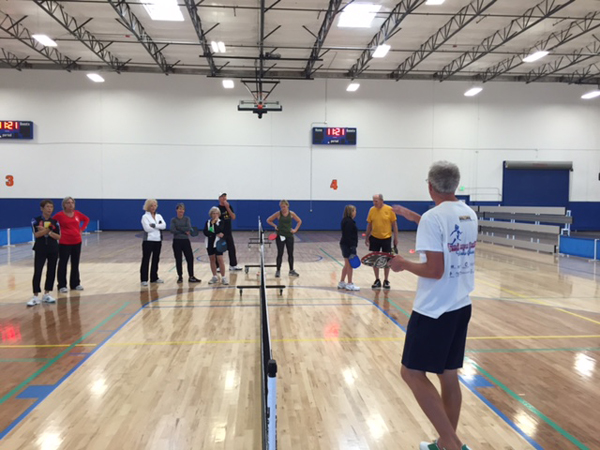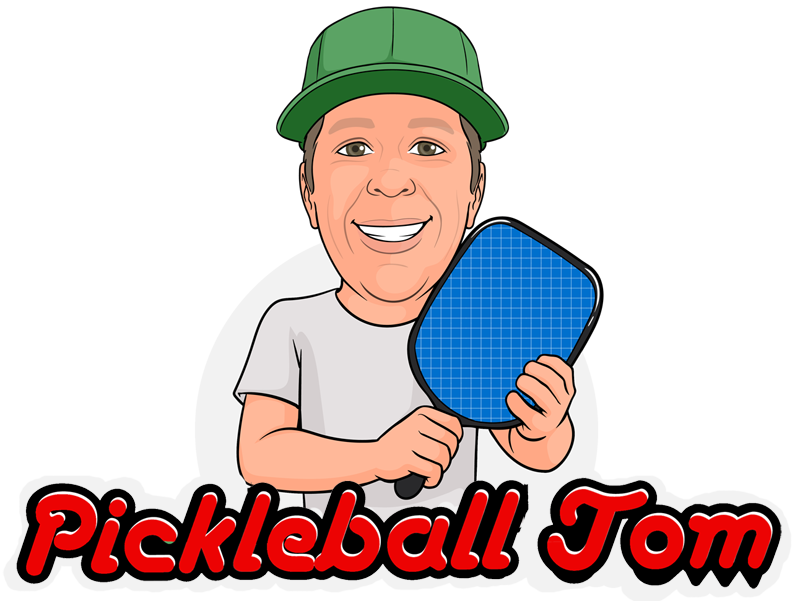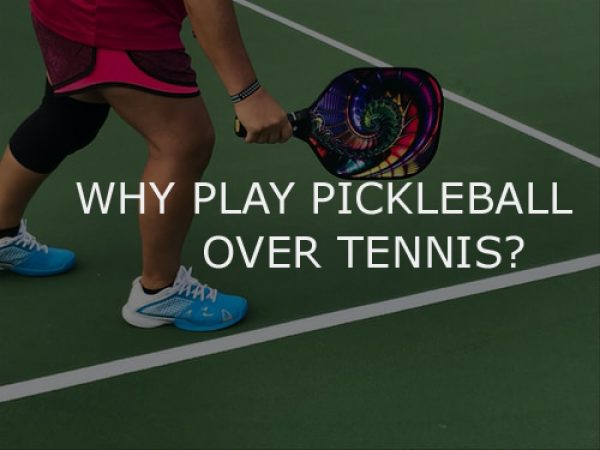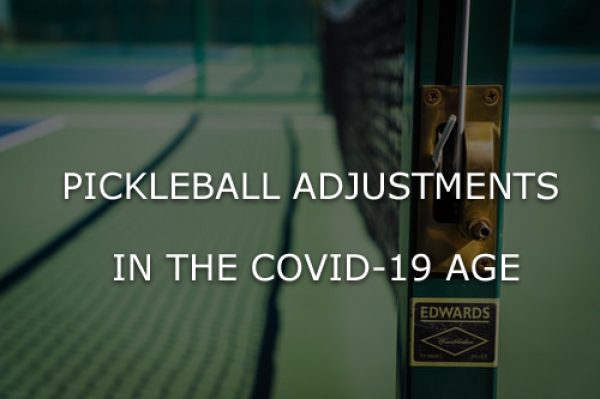The world is becoming more and more aware of Pickleball every day.
When I first heard about Pickleball from a friend of mine a few years ago
my response was “what’s Pickleball?”. As I get more involved with the
game and speak to other people about it a high percentage of the
responses are exactly what mine was “what’s Pickleball?”.
You have found this page so my guess is you already know the what? You
have probably seen it played or played it yourself, maybe many times. The
question this article will attempt to answer is why a person would want to
play Pickleball instead it’s much higher profile cousin Tennis?
We will go through many of the logistical, social, economic and health
reasons and see if you end up where I did.
Court size:
Pickleball courts are much smaller than Tennis courts in fact you can fit 4 Pickleball courts on 1 Tennis court, Pickleball court dimensions are 44’ long X 20’ wide. Typical configuration of a Tennis court converted to 4 Pickleball courts is this.
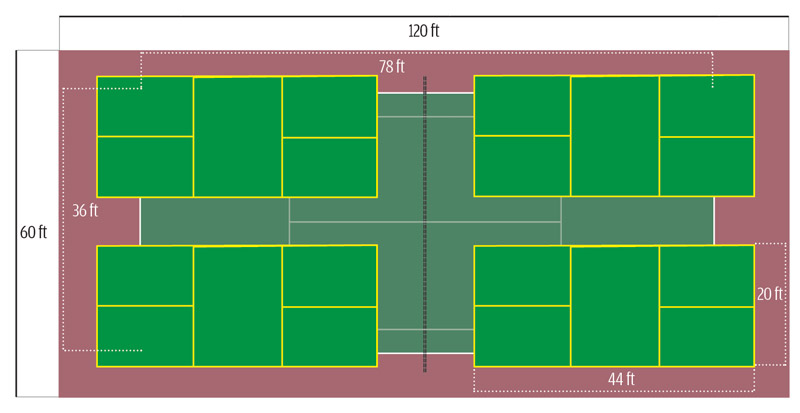
The advantages of the smaller court size are many, 1) you can have four times the people playing and getting exercise in a much smaller space. Since most Pickleball is played as doubles 16 people can play in the same space that a maximum of 4 tennis players would otherwise occupy. 2) Indoor play is much more likely if the space required is smaller. Pickleball courts can be set up in a variety of places like gymnasiums, recreation rooms, auditoriums and churches using a portable net and some masking tape. 3) There is less area to cover during play. Many of the Pickleball players are in their 50’s, 60’s, 70’s and even in their 80’s. Coupling doubles play with the smaller court size means the area a person needs to cover is much less daunting than in Tennis. 4) Temporary outdoor courts can be set up (again with a portable net and some masking tape) in a driveway or culde-sac or permanent courts can be installed in a backyard as the space required (allowing room outside the court to chase down balls) is only about 60’X30’.
Social: Pickleball tends to be somewhat different than Tennis. Most Tennis is organized by “setting up a game” 2 or 4 players set up the game and the time, meet there and play with the people they originally contacted with not much “drop in” play. Pickleball on the other hand is much more often just a “drop in” game. Some competitive Pickleball players will set up a game with comparable skill level players and play with those players exclusively and that is fine. However the vast majority of Pickleball is played at a set time, place and day and people just show up and play with whoever is there that day. At one of the Pickleball facilities in our area for example it is known in the Pickleball community that Monday and Thursday evenings from 5 to 8 or so if you want to play just show up with your paddle and ball and you will usually be able to play all the games you care to. In most areas there will be several times and days like that so you can usually find a time that fits your schedule. There will always be several skill levels at these “drop in” games and while that might not seem like the ideal situation because some games potentially would end up very lopsided. What usually happens is when 4 people enter the court to play a “drop in” game the strongest player (they usually know the skill level of the rest of the players that are there) will voluntarily take as their partner the player with the lowest skill level thus making the game much more even and fun. In addition to that the 2 mid level players on the other side of the net don’t typically “pick on” the weaker player and freeze out the stronger player. Socially the Pickleball community is out there for the exercise and the social aspects of the game. Wins and losses while are certainly noticed aren’t usually the main objective. Pickleball also seems to travel well. By that I mean if you are in a strange town and are looking for a little exercise and a whole lot of fun find a Pickleball court somewhere and jump in. A google search of Pickleball in the area will usually produce something to point you in the right direction. Given the nature of the Pickleball drop in style you can usually get into a game (or several) and at the same time meet some local people that can tell you about good local restaurants or things to do while you are in town. Who knows maybe you might make a friend or two?
Economy: Pickleball is a relatively inexpensive sport. Once you purchase a paddle and some balls for the most part you are good to go. Like anything you can spend quite a bit on a high end paddle (in the $200 range) and you can buy a portable net (anywhere from $150 to $400) but realistically you can get started with a $30 paddle and some balls (some of the balls (like the Onix Pure 2) seem to last forever!) and see where you go with it. As you progress in the game you may want to upgrade your paddle but that is optional. I play with several people that play with first paddle they bought and are fine with it. Most Pickleball is played outdoors at city parks on converted Tennis courts or current Tennis courts with Pickleball lines painted on them in addition to the Tennis lines. In those cases a temporary net is used for Pickleball. Let me make a comment about temporary Pickleball nets. While temporary nets aren’t quite as nice as permanent nets they are pretty close. They are very stable and the ball reacts much the same when it hits the top of the net (some are slightly better than others) as it does on a permanent net. If your area uses temporary nets exclusively don’t worry about it, they are fine. There are some outdoor Pickleball clubs that have yearly dues or “drop in” fees but they are usually pretty reasonable considering the quality of the facility and the availability of other people to play with. Indoor facilities, while some are no cost or very low cost because they are housed in some sort of city, county or non profit facility. They can sometimes be a little more expensive to play at given the fact that they are in some sort of a building and buildings aren’t typically free. You can spend a little money playing at those places and as I said they are usually worth it (especially in the snowy or rainy winter months) but there are usually plenty of places to play for free.
Health: Health is probably the best reason to play Pickleball (and Tennis too for that matter if your body can handle it) Getting out and doing a little running around is pretty much always a good thing. Pickleball is definitely less of a strain on your knees and ankles because of the smaller court dimensions and the fact that most Pickleball points usually require the participants to move either side to side or up and back just a few steps and not get into a dead run then need to stop and change direction quickly. There are exceptions to that of course but for the most part that is the case. I personally quit Tennis many years ago because of a shoulder issue that caused me problems when I served or hit an overhead. The weight of the racquet seemed to be the problem so I was forced to quit and didn’t find a replacement until I found Pickleball many years later. When I first started Pickleball I was afraid I was going to have the same issues with overhead shots (in Pickleball you serve underhanded so I knew that wasn’t going to be a problem) but that didn’t turn out to be a problem as the paddle usually only weighs 8 to 10 ounces and they aren’t very long so you don’t get that “whip” effect of the longer racquet. Everyone has heard of Tennis elbow, I know several people that have it and most but not all seem to have less pain playing Pickleball as opposed to Tennis. I’m guessing for the same reason as stated above?
Summary: Pickleball is an awesome game, if you haven’t tried it you should. If you are young and fit maybe Tennis is still the game for you, but given all the points above Pickleball is a fast growing game. It is one of the fastest growing games in the world according to NBC. Pickleball is very easy to learn (although the scoring system might seem a little odd at first) It is best if you have decent hand eye coordination but you can get away without a lot of mobility. Some of the best Pickleball players are ex (sometimes still) Tennis players. The skill set seems to translate well to Pickleball, the arm swing stroke seems to be slightly more consistent than a shot that uses more wrist (like racquetball) but both work.
So those are my reasons to either start playing or continue to play if you already do. Maybe someday We will cross paths on a Pickleball court somewhere in the world? Play well and enjoy the game!
Before I get into this topic let me say this virus is horrible! It is taking many lives, making others very sick and it is crushing the economy worldwide. There are so many more important things that we as humans are dealing with currently and will need to navigate going forward. Doing our best to stop or at least slow the spread of Covid-19 should be all of our top priorities. Please don’t take this as advocating putting yourself or others at risk by disregarding any local or country mandates. Pickleball as well as other sports and entertainment can wait if need be. Having said that at some point sooner or later we will want to get out and enjoy some recreation again, doing so as safely as possible is the goal here.
Covid-19 is here now and probably for the foreseeable future. At least until something drastically changes like a vaccine discovery or some other mitigation is invented. The Pickleball world (and just about every other sports, gathering and entertainment activity) has changed and it will be quite some time until something resembling “normal” returns.
The question is what to do now? Do we stop playing altogether? In some areas there is no choice as all of the Pickleball facilities are closed. Other areas still allow it although often in some modified version (no indoor and fewer outdoor venues). Even if you are in an area that has not closed or has not restricted play should we continue to play as we used to? What do you do if you set up a game with some people you know to be (or at least believe to be) virus free and someone else shows up and wants to play? So many questions! I will attempt to offer some opinions and direct you to a health expert and see if we can come up with something that makes sense in these troubled times.
Under normal circumstances Pickleball is usually played as a “drop in” game. People just show up at a given time and place and play with whoever is there that day. Socially that method is nice because you get to meet some interesting people and make some new friends with a shared interest. Most areas aren’t allowing that type of play currently and until there is a handle on the virus probably won’t for a while. In my area the outdoor courts (4 of them on 2 Tennis courts) remain open. Anyone can show up with a net and some balls and play. While it’s been quite some time since I’ve seen any actual “drop in” games going on. I have seen many times people playing together with little regard to physical distancing. They are continuing to play doubles with no gloves or masks and all using the same ball. This type of play would be acceptable if all the players lived together, but I know most of them and they don’t. Most of these players are relatively young and are very healthy so they don’t seem to be very concerned. These types of games defy many of the regulations set up in many areas and can really look bad for Pickleball in general. People seeing them out there back slapping, paddle tapping and hanging out too close together can give them a bad taste in their mouth about Pickleball. There are some alternatives that maybe we should consider during this unprecedented time.
Playing singles takes care of the physical distancing issues. In theory the closest you could get to your opponent is 14 feet (the 7 foot no volley zone line on both sides of the net). Even if one of the players went into the kitchen to hit a ball that bounces, their opponent would most likely be behind the line on their side of the net so at least 7 feet would be separating them. There is still the issue of using one ball. This can be rectified by each player using their own ball when they serve. When the rally is over if the server won the rally they serve again using the same ball and continue that way until they lose a rally. Then they put the ball in their pocket and the opponent serves using their ball. You need to get good at scooping up the ball and hitting it back to your opponent without touching it but with a little practice it’s pretty easy. The hard part is remembering not to touch your opponents ball. If you can’t master the scoop or you can’t seem to remember which ball not to touch you can always use a disposable glove on your non paddle hand, but keep your hands away from your face.
Now that you have mastered the art of physical distancing and having no points of contact while playing it is time to think about what kind of singles you want to play? In a perfect world we would just play on the full court. We would all have the stamina and mobility to play many games in a row on the entire court. That may be a little unrealistic for many of the players that frequent the majority of the Pickleball courts in the world. Looking at a Pickleball court and the fact that you can put 4 of them in the space of one Tennis court a person would think that there wouldn’t be that much area to cover and thus it wouldn’t be that taxing. They would be wrong, very wrong! Play full court if you can but if not don’t feel the least bit uneasy about playing 1/2 of the court often called skinny singles. It is a great game for several reasons. Skinny singles it is much more doable for most people. There is less area to cover and while it is more of a workout than doubles because of the style of play it is less than full court singles. Skinny singles is a GREAT way to practice your third shot drop and your dink game. Skinny singles can be played either straight on or diagonally. The types of shots you will typically play if you choose diagonal or straight will vary slightly but the overall premise is the same. The reason it is such good practice is because unless you have a smoking great serve the receiver not the server has the advantage. On a typical point the server serves (deep hopefully) then has to stay back to wait for the return to bounce (also hopefully deep) before they can hit it thus giving the returner the opportunity to run up to the no volley zone line and potentially control the point. The server can attempt to bang it hard and sometimes that works but a better strategy is to employ the third shot drop into the kitchen and move forward to the no volley zone line and start the dink game. Much of this strategy is the same as doubles play but players are forced to get proficient in both the third shot drop and the dink game in order to compete in skinny singles more than they would in doubles. You may personally enjoy banging it and when you go back to doubles you may not want to play either of these shots very often but having those shots in your arsenal will be helpful for your game when you need them.
My wife and I both play Pickleball although I play considerably more often than she does. Because I play so much more often my skill level is a little higher than hers. Attempting to play full court singles or skinny singles wouldn’t be a whole lot of fun for either of us. We came up with a solution that works very well for us. She is able to hit to my full court but I am only able to hit to the 1/2 of the court she served from. The game starts just like any full court singles game would. She serves from her even (right) side of the court to my even side, I return it to only the even half of the court. We play the point out and say she wins the rally, we each move to the odd (left) side of the our court and start again with me only able to hit to the odd side this time. We have a great time playing that way, it evens things out quite a bit and it’s a pretty good workout too!
There is however a way to play doubles relatively safely during the physical distancing directives. A household of people sheltering in place together could play Pickleball together using the same ball with little exposure to the virus. As long as they didn’t contact other people or their equipment during or after play it should be pretty safe. Two people that are sheltering in place together like spouses or children could in my opinion play doubles with some other sheltering in place couple with each couple using their own ball and no contact (like paddle tapping) during or after the games. A great youtube video on the on the subject is “pickleball in the time of covid-19”.
Anything resembling a tournament is probably off the table for a while as is typical “drop in” play but if we get a little creative, pay attention to good hygiene and be responsible there is probably some great and memorable Pickleball to be played once the sanctions are lifted. Hope to see you on a court somewhere in the world. Play well and play safe!
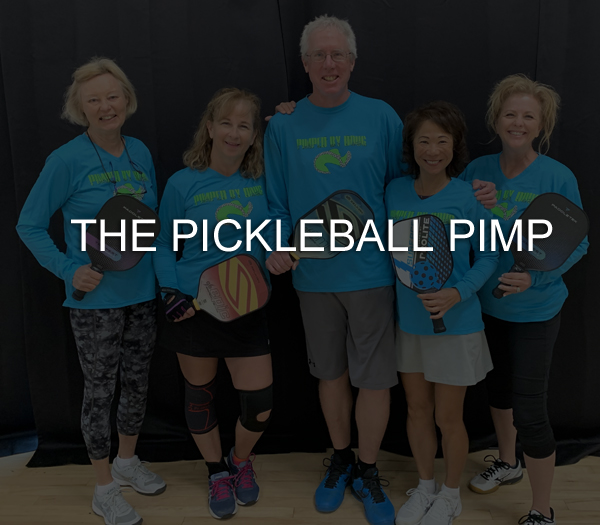
I recently met and have since taken some Pickleball lessons from a very accomplished local player named Doug Koch. He is a 5.0 player with quite a playing resume and from what I’ve seen a knack for imparting what he’s learned along the way to others. He goes by the nickname “The Pickleball Pimp” for his ability to put playing partners together. He gives individual and group lessons, puts on clinics and sells a little equipment all with the goal of financing his Pickleball addiction. I recently had a chat with him about a host of Pickleball subjects. I thought it may be interesting.
T) What is your Sports History and how did you get your Pickleball start?
D) I played all kinds of sports as a kid, ran track and cross country in high school. Played ping pong, tennis and squash recreationally during and after college. Was into running (10K’s half and full marathons) and mountain biking. I stayed pretty active. I got my Pickleball start in 2011 when my brother was at my house for my oldest daughter’s high school graduation. His in-laws live in Surprise Arizona so he had played there. He brought some paddles and a few balls with him, we stretched a badminton net between 2 garbage cans, used sidewalk chalk for the lines and played in my driveway. We ended up breaking the balls he brought and went to Big 5 and bought just about every kind of whiffle ball they had (no Pickleballs back then) to keep playing. We played all weekend and loved it, after he left I went looking for places and people to play with. I guess you could say I got hooked pretty quickly because before you knew it I was playing 4 to 5 times a week. I played my first tournament later that year with my brother and won a bronze medal at the 4.0 level. By the end of 2012 I had played in a few national events and had medaled often enough to move up to the 5.0 level.
T) Your tournament rating moved from a 4.0 to a 5.0 pretty quickly. From what I’ve seen people in tournaments tend to play at a level below their actual skill level (a 4.0 playing at a 3.5 or even 3.0) as defined by the USAPA’s player skill ratings guide. Can you speak to that?
D) When I started in Pickleball tournaments there was a player ratings committee that governed who played at what level. If a player had won or placed high often enough they were moved up to the next level going forward. My philosophy on ratings is if you are as skilled as 25% of the people in the next level it’s probably time to move up. Doing so challenges you to improve. Currently I see some people that are reluctant to move up even if they often dominate their current level so yes I think there is a bit of that going on. The USAPA now has a rating system in place that over time should level the playing field for all players.
T) Teaching is now a large part of your Pickleball life, how did you find yourself gravitating in that direction?
D) I have 2 daughters so as they grew up I coached them and their friends in soccer, basketball and track. After I got my masters degree I did some teaching for a while before I got into my career as a computer programer. As I started having some Pickleball success I had people come to me and ask if I would work with them to help them improve. Since I had some past experience in both coaching and teaching it turned out to be a very good fit. As I did more Pickleball coaching I did less computer programing and eventually I stopped coding all together.
T) When you start teaching someone at the beginner level what types of things do you focus on to help them get a good foundation to build on?
D) With a beginner I try to start with the basics of grip, movement, balance and next shot readiness. Teach them the serve fundamentals, the importance of getting a high percentage of serves and returns in and when possible deep in the court. I try to teach them good shot consistency and the importance of getting into the net as early in the point as possible. With beginners once they have the basics we really focus on consistency and keeping the ball in play to let your opponent make the mistake. Later we will get into anticipating where your opponent might try to attack you and where you want to attack them.
T) Same question about what you focus on teaching someone at the intermediate level?
D) At the intermediate level I try to refine their consistency even more. Teach them to not try to hit it too close to the lines or the net to improve the percentages of balls in play. Intermediates tend to try to hit the ball too hard when a softer shot with good placement would work just as well but with a higher conversion rate. Try to get them to recognize the value of hitting a softer shot into the kitchen to allow yourself and your partner the opportunity to establish position at the no volley line. Positioning at the no volley line is so important it can’t really be overstated, usually if one team has that position and the other one is at the baseline or stuck in no man’s land the team at the no volley line will win the vast majority of the points. Learning to hit balls that are hard to attack (balls that drop into the kitchen and require to be hit from below the top of the net) is an essential tool to move someone from intermediate to advanced.
T) Same question about what someone needs to move up to an advanced level?
D) At the advanced level most people have pretty much all the shots and are pretty good at being in the right place on the court most of the time. I try to focus on teamwork and trying to set your partner up for a high percentage shot whenever possible. Shot placement gets even more critical when you are playing against someone at a higher level so we work on that quite a bit. How to recognize what shots are attackable and how to attack them. The best way to put a ball away when you get the opportunity. I try to get them to recognize their opponents weaknesses and strengths and to try to stay away from the strengths and exploit the weaknesses whenever possible. Figure out what your opponent is ready for and hit something else if you can. For example if they are crowding the middle try to hit it down the line to get them reaching and off balance.
T) In general what fundamentals do you stress to all levels and why?
D) We have talked about on court positioning and that is always going to be important but along with that personal positioning is huge also, maybe even more so. What I mean by that is always be ready to hit a shot. Be on the balls of your feet, well balanced and with the paddle in the ready position out in front of your body. If you have just hit a shot that took you off balance or took your paddle out of the ready position get back to “ready” as soon as possible! Get in the habit of moving your feet to hit a shot instead of reaching for the ball. Your conversion rate will increase dramatically when you are centered over your feet with the paddle out in front. Learn to hit the ball when it is out in front of you rather than letting it get into your body of past you is also a very important skill for all levels. It is much easier to direct the ball where you want it to go if you hit it early rather than late.
T) You use Selkirk equipment, are you sponsored by them or is it your paddle of choice?
D) Both. They were a relatively new company. They gave me a few paddles to try at the 2015 nationals, I really liked them so they asked me to join team Selkirk. We signed an agreement and I have been playing their equipment ever since. They are a great company, in fact I recently received and started playing with their new Vanguard Carbon Fiber paddle which has a huge sweet spot & allows me to get more spin on my shots. They are very innovative and forward thinking. They are always trying to improve their equipment, I am very happy with the products they produce.
T) What is a good practice/play ratio for the average player?
D) A lot of the professionals practice 80% of the time. That isn’t something most recreational players will do. I tell people to warm up for 10 to 15 minutes before they play. Hit all the shots dinks, drives, drops, serves and volleys. Maybe play a little skinny singles but practice with a purpose not just to limber up before start the games. If you have someone willing to practice longer with you and you have the place to do it more is better.
The above is just an example of Doug’s thoughts on playing, teaching and living Pickleball. There was so much more as we spoke for over an hour. My recommendation would be if you live in the Sacramento area of northern California look Doug up @ pickleballpimp.com and schedule some sort of instruction either individual or group, you won’t regret it. For people living in other areas ask around and get some recommendations about local teachers and take a lesson, a little instruction can go a long way to help you get better and enjoy Pickleball even more!
Play well, maybe I’ll see you on a court someday.
